Photsosynthetic Response Peaks fall in the ranges of 425nm-475nm, 550nm-700nm. With primary responsive wavelengths being 600-675nm range (reds) and secondary at 425-450nm (blues) The entire range as recognized by science is 370-725nm.
Breaking it down by Kelvin we have:
Primary activity
6000-6500k Second Highest Peak
5500-5700k Highest Activity
2700-3000k Forth Peak
2200-2600K Third Peak
Secondary activity
3100k-5100k is 10% or less of photosynthetic activity (but still an active part in the process)
3000-3200k nutrient level light
3700k rapid growth development
5000k enhanced growth
By nm Bandwith:
Under 380 UV range has no influence??? (harmful below 315nm)
380-430 Violet Chloroplast Absorption begins
430-490 Blue Peak Absorbtion begins
490-560 Green (Supposed to be Dark to Plants) I do believe I read an article discussing a third chlorophyl using this range but on a micro level
560-590 Yellow Less Absorbtion
590-630 Orange Less Absorbtion
630-700 Red Significant influence on the flowering photosynthetic process
700-780 Far Red Flowering and Germination use
************CONVERSION FORMULA FOR NM TO KELVIN************
NM=3,000,000/kelvin (about as close as you are going to get anyway)
*******************************************************
So now we know what it needs and how it impacts. We can move on to Intensities.
The base measurement of intensity is Lux. Lux is defined as Lumens per square meter. Point of reference 1 meter equals 3.2808 ft. Intensity requirements are as follows:
*Total LUX vs End Result
1000-5000 Minimal necessary for life (1 23w twisty in a 3 sq/ft space)
10000-15000 Minimal neceassary for growth (equivilant of 7-9 23w twisties in a 3 sq/ft space)
20000-25000 Minimal for robust growth (most dollar store closet setups reside here)
25000-30000 Tropical Varieties (A 600W HPS in a 9-10 sq/ft room)
30000-50000 Equatorial Strain (Wanna Grow Fast?)
50,000 Lux is the equivilant of a bright summer day.
90,000 Lux is supposed to be the point at which growth becomes impaired and the photosynthetic process begins to fail.
*(Information found in various sources on the net)
Cruising along that brings us to LIGHT SOURCES!!! YaY time to really make some eyes raise and mindcogs turn.
Bulb Sources are: High Pressure Sodium (HPS), Low Pressure Sodium (LPS), Metal Halide (MH), Mercury Vapor (MV), Tungsten Quartz Halogen (HAL), and Flourescents (CFL) this will include t5's and such
HPS: 100-150 Lumens per watt (Lm/W) nanometer ranges 560-570,570-590,600-620,630 with the peak output being 560-570. Total Range emitted in nanometers (TR) 350-750
LPS: 150-200 Lm/W emits wavelength in a focused bandwith at 589-589.5 nm.
MH: 65-115 Lm/W wavelength emission at 490-510,520-550,565-660 with highest output at 580-590. TR 350-750
MV: 45-50 Lm/W Nanometer output peaks at 390-410,420-440,520-540,550-560 highest peak 420-440. TR 350-700
HAL: 21-30 Lm/W Nanometer peaks of 430,470-550,565-660 with highest peak at 580-620 TR 400-2700
CFL: 60-70 Lm/W Many different custom spectrums available but low intensity requiring dozens of bulbs to generate sufficient lux. Good for supplementing spectrums. There will be similar peaks in any floro lighting as mercury is used in all of them but they do put different phosphor coatings in to "correct" it to meet the advertised spectrum.
LED: 200+ Lm/W Once tech is mainstream and not so costly it will be the most efficient environmentally friendly way to grow. Anyone doubting the power of an led bulb just needs to stare directly into it long enough and then go to the hospital to see if the damage is irreparable. Led bulbs come in many colors and each is a specific wavelength. LED panels can be custom made to whatever light requirements are needed. I believe they would make the perfect wall and ceiling covering to be used in conjuction with the four main "intense" light sources. (HPS,HAL,MH,MV)
Halogen is an Ideal "black body radiator" putting out a nice continual spectral line from the UV Blue to far-red and beyond into the HEAT dissapation. That is the main problem with Halogen Light sources. Heat can be an extreme enemy. With adequate cooling it wouldn't be any more of a factor than a HPS source. The inefficient wattage thing can be debatable. A person using the heat for other purposes could make adequate use of them. I for instance cut my heating costs by two thirds this winter and my electric bill only went up by 1KW
((1000/1000*.06)*12)*30=$21.60 vs $200 in normal household heating cost increase during december.
CFL's tend to get a bad rap for being "weak" but enough of them in a confined space will yield fantastic results without undue heat issues and are close enough to MH in efficiency to consider using for a grower interested in building as they grow. Many growers find it easy to buy a few bulbs and fixtures over time rather than invest in one large expensive source. They have the additional advantages like diverse spectrums, your plants can grow into bulbs with little harm, multiple bulbs allows for your grow to keep going with little impact should a few fail when your not around. I find the 23-26 watt range seem to have the best Lm/W. Also the "y" splitters for $3 dollars and a few second hand 10 bulb bathroom fixtures can really spread the love around the room.
HPS and LPS both have extreme efficiency and great intensity. LPS is more of a luxury accent for those with the funding but the HPS has been a proven standard for growers world wide and with adequate ventalation will make for a great first investment lighting to get started with real results.
MH is the tech that replaced the MV with an efficiency increase and more pleasing to humans lighting spectrum. It's almost the same light but shifted slightly towards the right side of the nm scale with a "whitish" glow rather than a "voilet" hue. Both are prime for Veg and accenting the UV spectrum in a bloom room. I would give it to the MV for UV enthusiasts and steer others towards MH.
I would speak more on the HPS and MH but there is plenty of people already using them and as of yet I have not. They are however the standard in the industry with loads of documentation and proven results.
In summing up the lights and useful wavelengths we have:
Highest plant photsynthetic peaks at 425-450 (MV 420-440) and 600-675 (HPS 600-620,630 HAL 600-660 MH 600-630)
Facts were presented as unbiasly as possible. Make your own conclusions from the data given. Myself I believe ladies love lots of pretty colors and I plan on utilizing all of them as funding permits. If I could rewind a year I would have started with a 430 combined HPS/MH hood and added from there. As it stands I got everything else accumulated and hopefully in a few short months the 430 hood will grace my room with its presence. In the meantime I learned alot about light sources and the different contributions they give to the plant realm inside your house. I hope some information in this article is useful to someone somewhere. I know some folks will see MV and HAL and go "Garbage". In most respects they are right. They are not as efficient and the Halogen really heats the hell up but as far as spectrum outputs go the MV and HAL help give a full lineup of everything one needs by filling in the gaps left behind by HPS and MH.
Below is a listing of spectral graphs that can be found around the net for any who want cuneiform references.
Solar Data with others:
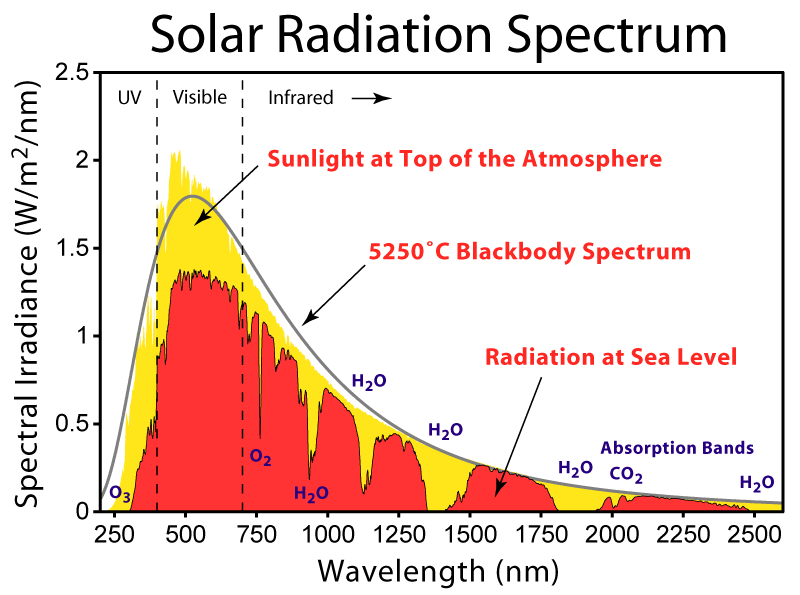


Photosynthesis data:



Various Lighting Source Spectral graphs:

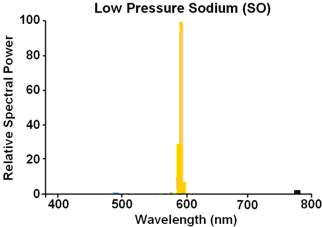
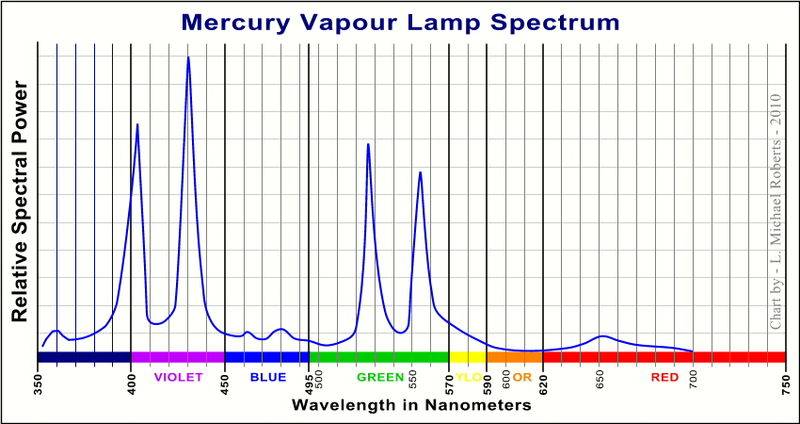

CFL (Blacklight, Natural, & Cool White) nm refernces listed in my lighting album.


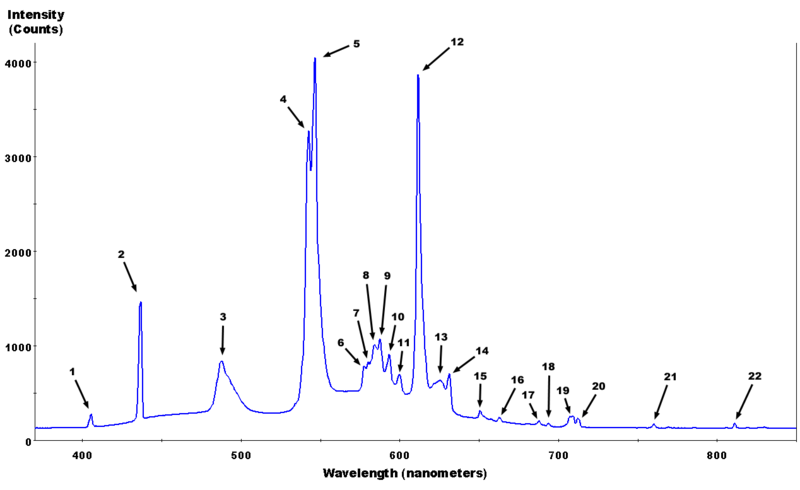
The "Black Body Radiator" Tungesten Quartz Halogen
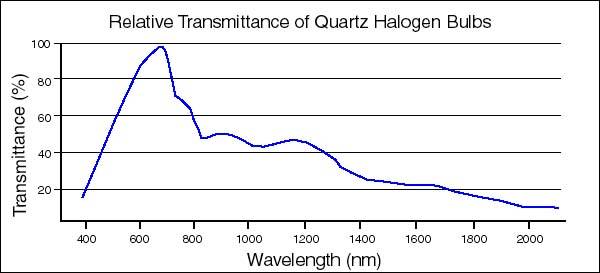
Great link for info and more charts on Halogen Lighting and how it performs as a full spectral black body radiator. http://zeiss-campus.magnet.fsu.edu/articles/lightsources/tungstenhalogen.html
Further fun can be obtained by building your own Spectrometer Try using a DVD rather than a CD it will obtain better results.
http://www.scienceinschool.org/2007/issue4/spectrometer
Breaking it down by Kelvin we have:
Primary activity
6000-6500k Second Highest Peak
5500-5700k Highest Activity
2700-3000k Forth Peak
2200-2600K Third Peak
Secondary activity
3100k-5100k is 10% or less of photosynthetic activity (but still an active part in the process)
3000-3200k nutrient level light
3700k rapid growth development
5000k enhanced growth
By nm Bandwith:
Under 380 UV range has no influence??? (harmful below 315nm)
380-430 Violet Chloroplast Absorption begins
430-490 Blue Peak Absorbtion begins
490-560 Green (Supposed to be Dark to Plants) I do believe I read an article discussing a third chlorophyl using this range but on a micro level
560-590 Yellow Less Absorbtion
590-630 Orange Less Absorbtion
630-700 Red Significant influence on the flowering photosynthetic process
700-780 Far Red Flowering and Germination use
************CONVERSION FORMULA FOR NM TO KELVIN************
NM=3,000,000/kelvin (about as close as you are going to get anyway)
*******************************************************
So now we know what it needs and how it impacts. We can move on to Intensities.
The base measurement of intensity is Lux. Lux is defined as Lumens per square meter. Point of reference 1 meter equals 3.2808 ft. Intensity requirements are as follows:
*Total LUX vs End Result
1000-5000 Minimal necessary for life (1 23w twisty in a 3 sq/ft space)
10000-15000 Minimal neceassary for growth (equivilant of 7-9 23w twisties in a 3 sq/ft space)
20000-25000 Minimal for robust growth (most dollar store closet setups reside here)
25000-30000 Tropical Varieties (A 600W HPS in a 9-10 sq/ft room)
30000-50000 Equatorial Strain (Wanna Grow Fast?)
50,000 Lux is the equivilant of a bright summer day.
90,000 Lux is supposed to be the point at which growth becomes impaired and the photosynthetic process begins to fail.
*(Information found in various sources on the net)
Cruising along that brings us to LIGHT SOURCES!!! YaY time to really make some eyes raise and mindcogs turn.
Bulb Sources are: High Pressure Sodium (HPS), Low Pressure Sodium (LPS), Metal Halide (MH), Mercury Vapor (MV), Tungsten Quartz Halogen (HAL), and Flourescents (CFL) this will include t5's and such
HPS: 100-150 Lumens per watt (Lm/W) nanometer ranges 560-570,570-590,600-620,630 with the peak output being 560-570. Total Range emitted in nanometers (TR) 350-750
LPS: 150-200 Lm/W emits wavelength in a focused bandwith at 589-589.5 nm.
MH: 65-115 Lm/W wavelength emission at 490-510,520-550,565-660 with highest output at 580-590. TR 350-750
MV: 45-50 Lm/W Nanometer output peaks at 390-410,420-440,520-540,550-560 highest peak 420-440. TR 350-700
HAL: 21-30 Lm/W Nanometer peaks of 430,470-550,565-660 with highest peak at 580-620 TR 400-2700
CFL: 60-70 Lm/W Many different custom spectrums available but low intensity requiring dozens of bulbs to generate sufficient lux. Good for supplementing spectrums. There will be similar peaks in any floro lighting as mercury is used in all of them but they do put different phosphor coatings in to "correct" it to meet the advertised spectrum.
LED: 200+ Lm/W Once tech is mainstream and not so costly it will be the most efficient environmentally friendly way to grow. Anyone doubting the power of an led bulb just needs to stare directly into it long enough and then go to the hospital to see if the damage is irreparable. Led bulbs come in many colors and each is a specific wavelength. LED panels can be custom made to whatever light requirements are needed. I believe they would make the perfect wall and ceiling covering to be used in conjuction with the four main "intense" light sources. (HPS,HAL,MH,MV)
Halogen is an Ideal "black body radiator" putting out a nice continual spectral line from the UV Blue to far-red and beyond into the HEAT dissapation. That is the main problem with Halogen Light sources. Heat can be an extreme enemy. With adequate cooling it wouldn't be any more of a factor than a HPS source. The inefficient wattage thing can be debatable. A person using the heat for other purposes could make adequate use of them. I for instance cut my heating costs by two thirds this winter and my electric bill only went up by 1KW
((1000/1000*.06)*12)*30=$21.60 vs $200 in normal household heating cost increase during december.
CFL's tend to get a bad rap for being "weak" but enough of them in a confined space will yield fantastic results without undue heat issues and are close enough to MH in efficiency to consider using for a grower interested in building as they grow. Many growers find it easy to buy a few bulbs and fixtures over time rather than invest in one large expensive source. They have the additional advantages like diverse spectrums, your plants can grow into bulbs with little harm, multiple bulbs allows for your grow to keep going with little impact should a few fail when your not around. I find the 23-26 watt range seem to have the best Lm/W. Also the "y" splitters for $3 dollars and a few second hand 10 bulb bathroom fixtures can really spread the love around the room.
HPS and LPS both have extreme efficiency and great intensity. LPS is more of a luxury accent for those with the funding but the HPS has been a proven standard for growers world wide and with adequate ventalation will make for a great first investment lighting to get started with real results.
MH is the tech that replaced the MV with an efficiency increase and more pleasing to humans lighting spectrum. It's almost the same light but shifted slightly towards the right side of the nm scale with a "whitish" glow rather than a "voilet" hue. Both are prime for Veg and accenting the UV spectrum in a bloom room. I would give it to the MV for UV enthusiasts and steer others towards MH.
I would speak more on the HPS and MH but there is plenty of people already using them and as of yet I have not. They are however the standard in the industry with loads of documentation and proven results.
In summing up the lights and useful wavelengths we have:
Highest plant photsynthetic peaks at 425-450 (MV 420-440) and 600-675 (HPS 600-620,630 HAL 600-660 MH 600-630)
Facts were presented as unbiasly as possible. Make your own conclusions from the data given. Myself I believe ladies love lots of pretty colors and I plan on utilizing all of them as funding permits. If I could rewind a year I would have started with a 430 combined HPS/MH hood and added from there. As it stands I got everything else accumulated and hopefully in a few short months the 430 hood will grace my room with its presence. In the meantime I learned alot about light sources and the different contributions they give to the plant realm inside your house. I hope some information in this article is useful to someone somewhere. I know some folks will see MV and HAL and go "Garbage". In most respects they are right. They are not as efficient and the Halogen really heats the hell up but as far as spectrum outputs go the MV and HAL help give a full lineup of everything one needs by filling in the gaps left behind by HPS and MH.
Below is a listing of spectral graphs that can be found around the net for any who want cuneiform references.
Solar Data with others:
Photosynthesis data:
Various Lighting Source Spectral graphs:
CFL (Blacklight, Natural, & Cool White) nm refernces listed in my lighting album.
The "Black Body Radiator" Tungesten Quartz Halogen
Great link for info and more charts on Halogen Lighting and how it performs as a full spectral black body radiator. http://zeiss-campus.magnet.fsu.edu/articles/lightsources/tungstenhalogen.html
Further fun can be obtained by building your own Spectrometer Try using a DVD rather than a CD it will obtain better results.
http://www.scienceinschool.org/2007/issue4/spectrometer
Last edited:



 to messn'n'gommin' nice reference material!
to messn'n'gommin' nice reference material!
